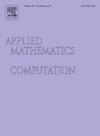Collaborated risk perception against multiple epidemics in a multiplayer network
IF 3.4
2区 数学
Q1 MATHEMATICS, APPLIED
引用次数: 0
Abstract
The concurrent outbreak of epidemics has become a great threat to public health. An important problem is how individuals can protect themselves as the mandated protective measures are relaxed. Previous studies developed various models to investigate the correlated spreading dynamics of concurrent epidemics and the protective measures against them. However, a critical oversight remains that people’s risk perceptions on multiple epidemics are also correlated or even collaborated. In this paper, we build an SS-IS-SI-II coupled model in a multilayer network to describe two concurrent epidemics, integrating collaborated risk perception and spontaneous social distancing as individuals’ self-protection. Moreover, an adjustable coefficient is proposed to describe different levels of inter-epidemic correlations (competition/independence/cooperation). It is found that increasing the levels of inter-epidemic correlation will increase the infected density of both epidemics. Collaborated risk perception is generally more effective in reducing infections across different levels of inter-epidemic correlation, compared with independent risk perception. But its effect is dependent. For one epidemic, when its infectivity is very high or the infectivity of the other epidemic is very low, the effect of collaborated risk perception will be largely reduced. Based on the model, we further investigate the minimum social distancing required to contain epidemics under different conditions, and the priority on different layers is also explored. This research extends existing literature on co-evolutional epidemic dynamics, and lay a foundation to model correlated risk perceptions against epidemics. The results provide implications for individuals to take self-protection against concurrent epidemics.
多人网络中针对多种流行病的协作风险感知
流行病的同时爆发已成为对公共卫生的巨大威胁。一个重要的问题是,随着强制性保护措施的放松,个人如何保护自己。以往的研究建立了各种模型来研究并发流行病的相关传播动态和预防措施。然而,一个重要的疏忽仍然存在,即人们对多种流行病的风险认知也是相关的,甚至是相互协作的。本文在多层网络中构建了一个SS-IS-SI-II耦合模型,将协作风险感知和自发社会距离作为个体的自我保护,来描述两种并发流行病。此外,提出了一个可调系数来描述不同程度的流行病间相关性(竞争/独立/合作)。研究发现,增加两种流行间的相关程度,会增加两种流行的感染密度。与独立风险感知相比,协作风险感知在减少不同程度的流行病间相关性感染方面通常更有效。但其效果是有依赖性的。对于一种流行病,当其传染性很高或另一种流行病的传染性很低时,协作风险感知的作用将大大降低。在此基础上,我们进一步研究了不同条件下控制疫情所需的最小社会距离,并探讨了不同层次上的优先级。本研究扩展了关于共同进化流行病动力学的现有文献,并为建立流行病相关风险感知模型奠定了基础。这一结果为个人采取自我保护措施预防同时发生的流行病提供了启示。
本文章由计算机程序翻译,如有差异,请以英文原文为准。
求助全文
约1分钟内获得全文
求助全文
来源期刊
CiteScore
7.90
自引率
10.00%
发文量
755
审稿时长
36 days
期刊介绍:
Applied Mathematics and Computation addresses work at the interface between applied mathematics, numerical computation, and applications of systems – oriented ideas to the physical, biological, social, and behavioral sciences, and emphasizes papers of a computational nature focusing on new algorithms, their analysis and numerical results.
In addition to presenting research papers, Applied Mathematics and Computation publishes review articles and single–topics issues.

 求助内容:
求助内容: 应助结果提醒方式:
应助结果提醒方式:


